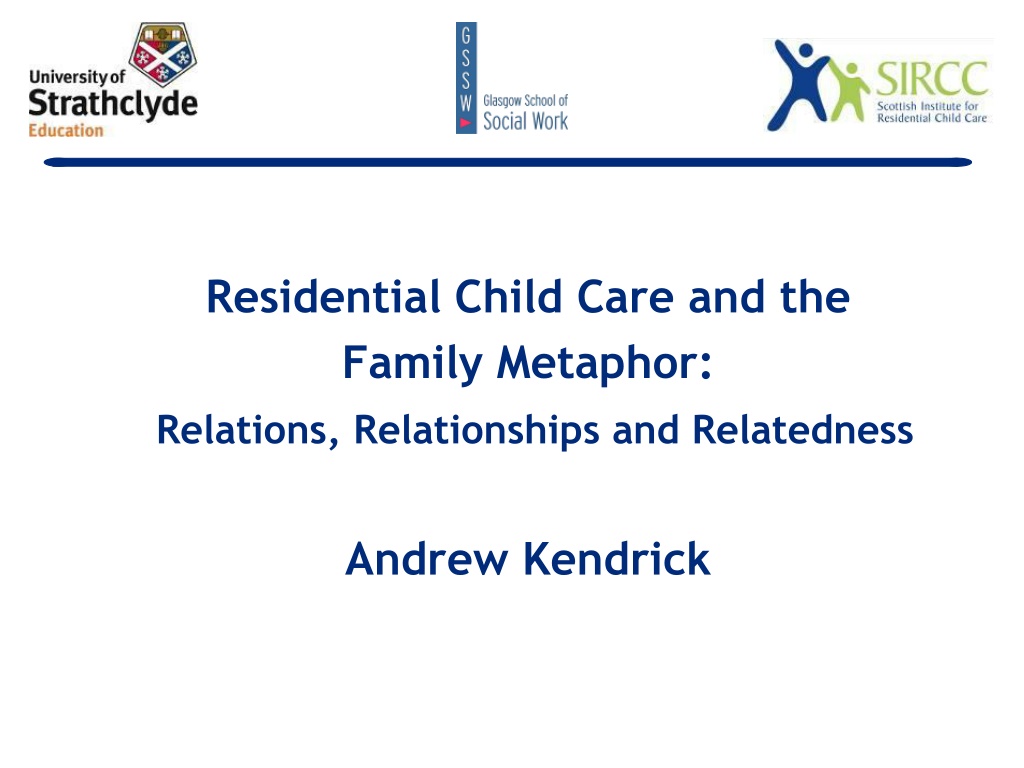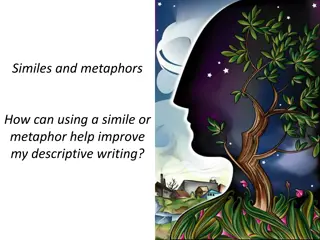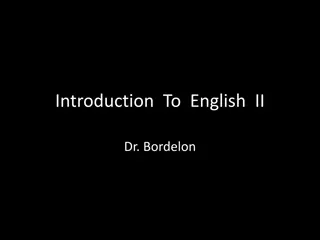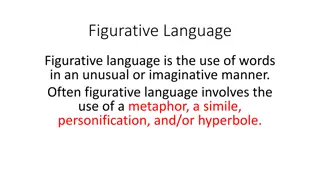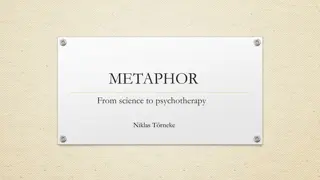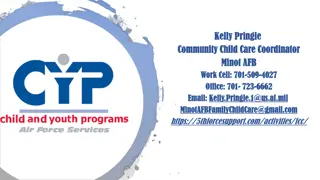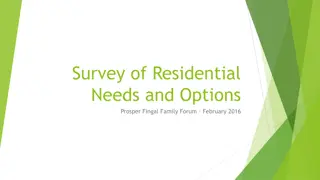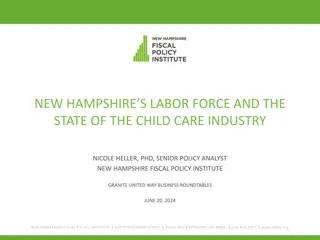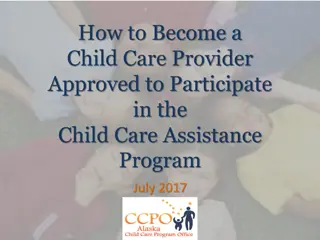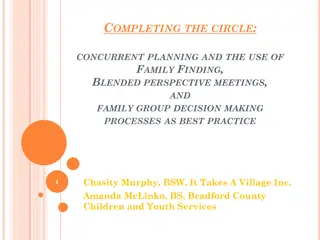Exploring Residential Child Care and Family Metaphors
The content discusses the importance of providing warmth and care for children's healthy development in residential child care settings. It delves into ongoing concerns, biases, and challenges faced in such care, highlighting the significance of familial relationships for the well-being of children. Quotes from young individuals reflect on the familial bonds formed in these environments, emphasizing the role of relationships in providing support and a sense of belonging.
Download Presentation

Please find below an Image/Link to download the presentation.
The content on the website is provided AS IS for your information and personal use only. It may not be sold, licensed, or shared on other websites without obtaining consent from the author. Download presentation by click this link. If you encounter any issues during the download, it is possible that the publisher has removed the file from their server.
E N D
Presentation Transcript
Residential Child Care and the Family Metaphor: Relations, Relationships and Relatedness Andrew Kendrick
it is essential that we provide the necessary warmth, affection and comfort for children's healthy development if we are not further to damage emotionally children and young people who have usually had a raw deal from life (Children s Safeguards Review, 1997)
Ongoing concerns about residential child care Another Kind of Home Skinner Report Children s Safeguards Review Kent Report Historical Abuse Systemic Review Shaw Report National Residential Child Care Initiative
Ongoing concerns about residential child care Defensive practice Kent s sterile environment Poor outcomes education health employment Continued ambiguity about residential child care
Anti-residential bias Family Residential Good Bad Safe Risky Natural Unnatural Homely Institutional
Issues with the family the ideal of the nuclear family from the nuclear family to the unclear family Measured against the cereal-packet norm of the nuclear family, it is complex, with children and resources linking households across space and time, in ways which render the identification of family with a single, discrete household wholly misleading. (Simpson, 1994) the breakdown of the family the root of lack of social cohesion the locus of poverty and social exclusion
Family as metaphor in residential care Eddy s always been there, but me and Eddy have bonded all well, that s what I m saying. I call him, he s my dad, you know what I mean, but he seemed to have always been there when I was restrained or, anytime I m angry, I ve left the building, he always seems to be there. (young person) (Steckley and Kendrick, 2005) She was like, a, like a sister, because we you know, we figured we looked alike and we were really close. She was like family to me. (young person) (Jim Anglin, 2002) I always regarded this place as my house.. Everybody that was here was part of my family. All I ve wanted for the last three, four years is somebody to be there for me. Somebody I can turn round to and talk to. (young person) (BBC, Social Workers)
Linking with kinship studies Cultural definitions of family are very different Cultures of relatedness biology/nature social structure process/lived experience Thus the ideas I describe lead me to question the division between the "biological" and the "social," between kinship as a biological, genetic, instant, and permanent relationship, and social identity as fluid. In Langkawi, ideas about relatedness are expressed in terms of procreation, feeding, and the acquisition of substance, and are not predicated on any clear distinction between "facts of biology" (like birth) and "facts of sociality" (like commensality). (Carsten, 1995)
Families of Choice anthropological and sociological studies of gay and lesbian kinship disruptions to, and severance of, kinship ties experienced by gays who declare their homosexuality to their families. chosen families of friends are invested with certainty, depth, and permanence, and spoken about in the idiom of kinship
Not simply families of fate or choice we have suggested that the imputed dichotomous contrast between given and chosen relationships is analytically shallow and that, in practice, there is a complex process of suffusion between familial and non-familial relationships. (Pahl and Spencer, 2004) children who, for whatever reason, are in state institutions may consider certain professional carers, highly committed to them, as given , although later in life they may recognize that their commitment could not be reciprocal. (Pahl and Spencer, 2004)
Not simply families of fate or choice High Commitment traditional family fictive kin close friends Low Commitment more distant kin Given Relationships Chosen Relationships Routine relations (of work, etc) Pahl and Spencer (2004)
Blurring of boundaries The boundary between familial and non-familial relationships is increasingly blurred in everyday lives. There is certainly evidence for an extension of family relationships in terms of the language used so that individuals and practices may be described as being like family where it is clear that this is a positive evaluation. It is also evident from some of our studies that these non-familial intimate relations provide practical and emotional support for particular family members in such a way as to enable particular clusters of family relationships and practices to continue. (Jamieson et al. 2006)
Children creating like-family kinship a special relationship that seemed like family with someone who was, geneologically speaking, unrelated to them. children liked the person and interpersonal and interactive elementswere relevant shared biography and borrowed relational biographies creativity and electivity Perhaps most importantly, we have argued that children s like-family relationships are forms of kin relationship that children value. (Mason and Tipper, 2008)
We met a number of participants who had experienced feeling accepted, secure and a sense of belonging in residential care. In the best experiences, participants thought of their residential carers as a kind of family What often characterised the positive relationships in residential care was the continuing sense of security and safety, which could be relied on. (Happer, MacCreadie and Aldgate 2006, p.17)
Back to outcomes in residential child care a recent review and meta-analysis of research on residential child care concludes that children and young people, on average, improve in their psychosocial functioning (Knorth et al, 2008) the limited research on residential child care also found that generally children did better following time in residential care than they were doing beforehand (Forrester, 2008)
Back to outcomes in residential child care when the nature of the aims of placements is taken into account, foster placements and residential placements were equally successful in achieving their specific aims (Kendrick, 1995) if one takes account of behaviour, age and age at entry, children s homes are not significantly less successful than other placements (Sinclair et al.,2007)
The centrality of relationships between young people and staff several of the studies of residential homes explained successful residential care according to the quality of the interaction between young people and adults. Terms used include: empathy; approachability; persistence; willingness to listen and reliability (Berridge, 2002) attachment theory, resilience theory have highlighted this centrality of relationship
Whitaker, Archer and Hicks (1998) being ready to listen, both to the evidently momentous and to the apparently mundane being sensitive to a young person s readiness, or not, to talk and to share feelings and experiences combining non-verbal or symbolic forms of caring with verbal, explicit ones noticing good or admirable behaviour and crediting a young person for it marking special occasions in a young person s life with a celebration.
Back to cultures of relatedness alongside individual relationships between children and young people and residential staff members the sense of relatedness brought about by routines, rhythms and rituals of daily living sharing of food involvement in cultural and leisure activities the living space and the environment
A sense of normality it would appear that creating a sense of normality for the residents without attempting to pretend that a group home setting is either normal or normative is vital for their sense of well-being (Anglin, 2002) Intimate familiarity importance [of] the fact that the relationships were possessed of a particular characteristic. I have come to think of that characteristic as intimate familiarity. (Garfat, 1998)
It is in understanding children and young peoples centrality in the complex mesh of relations, relatedness and relationships that residential child care must find its true potential.
They didnt treat it like residential, they treated me like family, basically there was one worker who treated me like a daughter it was more like a family home than residential (Female, 17)
Anglin, J. (2002) Pain, normality, and the struggle for congruence: Reinterpreting residential child care.Binghampton: Haworth Press. Carsten, J. (1995) The substance of kinship and the heat of the hearth: Feeding, personhood, and relatedness among Malays in Pulau Langkawi, American Ethnologist 22, 223-241. Carsten, J. (ed) (2000) Cultures of relatedness: New approaches to the study of kinship. Cambridge: Cambridge University Press. Carsten, J. (2004) After kinship. Cambridge, Cambridge University Press. Forrester, D. (2008) Is the care system failing children? The Political Quarterly 79(2), 206-211. Garfat, T. (1998) The effective child and youth care intervention: A phenomenological inquiry. Journal of Child and Youth Care, 12(1-2) Happer, H., MacCreadie, J. & Aldgate, J. (2006) Celebrating Success: What Helps Looked After Children Succeed. Edinburgh: Social Work Inspection Agency. Jamieson, L., Morgan, D., Crow, G. & Allan, G. (2006) Friends, neighbours and distant partners: Extending or decentring family relationships., Sociological Research Online, 11(3). <http://www.socresonline.org.uk/11/3/jamieson.html>. Kendrick, A. (1995). Residential care in the integration of child care services. Edinburgh: HMSO/Central Research Unit. Kendrick, A. (ed.) (2008) Residential child care: Prospects and Challenges. London: Jessica Kingsley. Mason, J. & Tipper, B. (2008) Being related: How children define and create relatedness, Childhood 15(4), 441-460. Pahl, R. & Spencer, L. (2004) Personal communities: not simply families of fate or choice . Current Sociology, 52(2), 199-221. Simpson, B. (1994) Bringing the unclear family into focus: Divorce and re-marriage in contemporary Britain, Man, 29(4), 831- 851 Sinclair, I., Baker, C., Lee, J. & Gibbs, I. (2007) The pursuit of permanence: A study of the English child care system. London: Jessica Kingsley Publishers. Steckley, L. & Kendrick, A. (2005) Physical restraint in residential child care: the experiences of young people and residential workers. Childhoods: Children and Youth in Emerging and Transforming Societies International Conference, 29 Jun - 3 Jul 2005, Oslo, Norway. Whitaker, D., Archer, L. and Hicks, L. (1998) Working in children s homes: Challenges and Complexities. Chichester: Wiley.
